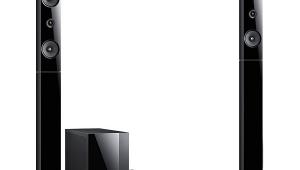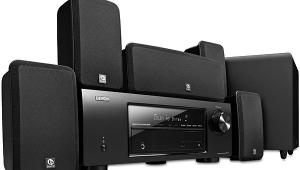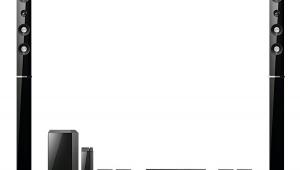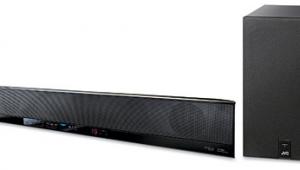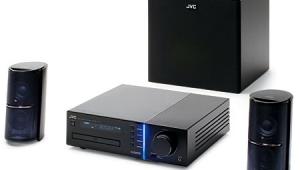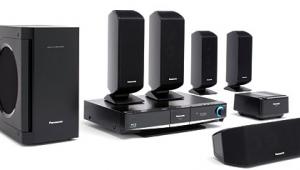Samsung NeXus 50 XM Player and HT-Q45 HTIB
I'll admit it. I'm a fan of satellite radio. The sound quality, the variety of programming, the lack of commercials, and even the bonuses like artist and song-title info on display are all enticing to me. And yet, a compelling satellite radio product hasn't landed on my desk in some time—or perhaps one did but was lost among all the press releases, UPS receipts, and slightly used napkins. As if to make up for the lull, Samsung hooked me up with two disparate new products that work great together, converging the freedom of a portable digital audio player with the convenience and versatility of a complete home theater in a box.

My MP3 Player Can Beat Up Your MP3 Player
The NeXus 50 portable is so named because it stores up to 50 hours of XM Satellite Radio programming, which it can compress to proprietary, variable-bit-rate ACT files—retaining full artist/title tags—and record to its 1 gigabyte of embedded flash memory. (A less expensive NeXus 25 model is also available.) One important point up front: This is not a portable XM2go device. Although it can play MP3 and WMA files, it can only receive live XM broadcasts in either the home dock (included) or with the car kit (sold separately). When you connect it to the home dock, you can set a memory partition for either 100-percent XM content or a 50/50 XM/MP3-WMA split. The dock also accepts the new XM Passport chip. This novel and handy device is a removable digital key that contains the unique account information to enable XM reception on multiple devices. Also in the box is a back-breaking complement of other accessories: a compact remote; a home antenna; an AC adapter; a mini-stereo-to-RCA-type audio cable; a USB cable; a belt clip; adequate earbuds; and a removable, rechargeable, long-life lithium-ion battery.
One of the system's most cunning functions is its ability to bookmark any given XM track you've recorded. To what end? You get a PC CD-ROM with the XM + Napster software. This brings an enhanced set of options to the tried and true Napster, including the ability to purchase any song you've flagged as a full-resolution Napster (WMA-DRM) download. After all, the spin on this product is to make it easier and more enjoyable to access the music you want. I captured several hours of the Starbucks channel overnight to listen to on my commute the next day.
In addition to broadening my musical horizons, I was also reminded of various songs I'd never gotten around to adding to my personal library. A few presses of the simple on-player buttons, guided by a basic menu, noted my picks. When I docked the NeXus and connected the cradle to my PC back at home, a slightly buggy XM + Napster interface reminded me of my "greatest hits." However, not all of my favorites were available from Napster. It let me play most of the recorded XM tracks on my connected computer, with album art. Recorded XM tracks remain playable as long as you keep paying your subscription. When all of the hardware is properly connected to your PC, you can also use the mouse and keyboard to schedule recording sessions by time and channel.
 XM + Napster further allows access to about 80 XM Radio Online music channels, with artist info just a few clicks away. The entry-level Napster membership, at no additional cost beyond the $13 per month for XM—or just plain free for non-XMers—is Napster Light. It offers 30-second previews of songs in the Napster catalog, and you can buy these WMA-DRM tracks for $1 and later transfer them to the NeXus or to Samsung's sister XM portable device, the Helix. Napster To Go is a different subscription altogether, with unlimited song downloads for an ongoing monthly fee. However, neither the NeXus nor the Helix is compatible with this service. As far as the XM recordings on my NeXus, I learned the hard way that any reception dropouts during the original content capture are forever preserved in the library, so be sure to position the antenna wisely. High frequencies are the first aspect of sound quality to suffer in the XM file compression, and the presentation tends to squash some notes of songs during playback. You can use the onboard menus to search by artist, song title, and other criteria.
XM + Napster further allows access to about 80 XM Radio Online music channels, with artist info just a few clicks away. The entry-level Napster membership, at no additional cost beyond the $13 per month for XM—or just plain free for non-XMers—is Napster Light. It offers 30-second previews of songs in the Napster catalog, and you can buy these WMA-DRM tracks for $1 and later transfer them to the NeXus or to Samsung's sister XM portable device, the Helix. Napster To Go is a different subscription altogether, with unlimited song downloads for an ongoing monthly fee. However, neither the NeXus nor the Helix is compatible with this service. As far as the XM recordings on my NeXus, I learned the hard way that any reception dropouts during the original content capture are forever preserved in the library, so be sure to position the antenna wisely. High frequencies are the first aspect of sound quality to suffer in the XM file compression, and the presentation tends to squash some notes of songs during playback. You can use the onboard menus to search by artist, song title, and other criteria.
Can Your HTIB Do This?
The HT-Q45 home theater system claims an impressive 800 watts of total power, with 135 watts reserved for the front-ported, side-firing, particleboard-enclosed subwoofer. I can't recall the last time I saw an HTIB sub connected via standard bare-wire speaker clips. Because the subwoofer contains no amplification of its own, the housing is extremely lightweight. The system plays rather loudly, albeit not painfully so, when pushed to its limits. Not surprisingly, though, at high volumes, it does tend to distort, particularly in the low end, with an unpleasant echo effect. There are also some mildly distracting limits on voices in the center channel and an overall muddiness to what should be sonic detail. The small satellites are more localized within the soundfield than I would like. Neither did the HT-Q45 render a clean picture from heavily compressed video. Shadow detail was restricted, and it fared poorly on all aspects of the Faroudja/Sage demo disc. At least the five-disc carousel made switching between my test discs a piece of cake.
The HT-Q45 is XM ready if you add the optional XM Connect antenna or—and this is the cool part—if you run a proprietary cable from the NeXus dock to the jack on the rear of the DVD/receiver unit. Surprisingly, this cable is not included with either product. And, since the dock uses the XM Passport, only one subscription is necessary to enjoy XM with either piece of hardware. This HTIB is also wireless ready. You can upgrade to optional wireless surround speakers with a TX card, while the front-panel USB host port improves the plug-and-play experience for direct patching. There's also remote control of the music and photos within select digital cameras, MP3 players, removable hard drive/flash storage devices, and card readers. The HT-Q45 supports Samsung's AnyNet interface, which controls other AnyNet-enabled devices. Samsung has come up with a potentially money-saving way to link two very different products with a relatively low buy-in. While the list of features is lengthy, the HTIB's audio quality and video performance are sadly lacking. On its own, however, the NeXus device is a wonderful new way to enjoy XM content and more—in the living room, at the computer, or on the go.
Highlights
• Broad capabilities—XM Satellite Radio, DVD-Audio, USB Host—in a low-cost HTIB
• NeXus device can tune XM when docked and elegantly play cached XM, MP3s, or WMAs anywhere
• Together, they take advantage of the new XM Passport, so multiple XM receivers share one subscription
- Log in or register to post comments
